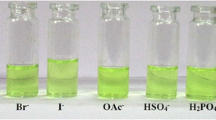Abstract
Mannich Base (MB) based (β-Amino carbonyl compound) (4) was synthesized by adopting one pot Mannich reaction by taking 3,4-dihydroxybenzaldehyde, aniline and acetophenone as starting materials and the product was characterized using analytical techniques such as FT-IR, NMR, mass spectrometry, UV-Visible spectroscopy. The compound 4 utilized as colorimetric sensor for selective sensing of F− ions. The particular sensing of F− is obviously noticeable to the naked eye with a dissimilar colour variation. The F− detection mechanism has been examined by UV-visible and 1H NMR titration experimentations. The 1H NMR titration data describes the deprotonation of OH and N-H protons by F− as a noticeable stage in the detection. Furthermore, the studies was also carried out for reproduction of deprotonated 4 using trifluoroacetic acid as protonating agent. In addition, Boolean logic gates were fabricated for demonstrating the fluoride sensing mechanism and compound 4 in methyl cellulose biofilm was also been made and effectively used for film based detection of fluoride ion.










Similar content being viewed by others
References
Ashok kumar SL, Tamilarasan R, Saravana Kumar M, Sreekanth A (2011) Bisthiocarbohydrazones as colorimetric and “turn on” fluorescent chemosensors for selective recognition of fluoride. Ind Eng Chem Res 50:12379–12383
World Health Organisation (2006) Guidelines for drinking-water quality. World Health Organisation, Geneva, pp 1–9
Kumari N, Jha S, Bhattacharya S (2011) Colorimetric probes based on anthraimidazolediones for selective sensing of fluoride and cyanide ion via intramolecular charge transfer. J Org Chem 76:8215–8222
Lin CI, Selvi S, Fang JM, Chou PT, Lai CH, Cheng YM (2007) Pyreno[2,1- b ]pyrrole and Bis(pyreno[2,1- b ]pyrrole) as selective Chemosensors of fluoride ion: a mechanistic study. J Org Chem 72:3537–3542
Mahanta SP, Kumar BS, Baskaran S, Sivasankar C, Panda PK (2012) Colorimetric sensing of fluoride ion by new expanded calix[4]pyrrole through anion-π interaction. Org Lett 14:548–551
Qu Y, Hua J, Tian H (2010) Colorimetric and Ratiometric red fluorescent Chemosensor for fluoride ion based on Diketopyrrolopyrrole. Org Lett 12:3320–3323
Yang Z, Zhang K, Gong F, Li S, Chen J, Ma JS, Sobenina LN, Mikhaleva AI, Trofimov BA, Yang G (2011) A highly selective fluorescent sensor for fluoride anion based on pyrazole derivative: naked eye “no–yes” detection. J Photochem Photobiol A 217:29–34
Bhosale SV, Kalyankar MB, Langford SJ (2009) A core-substituted naphthalene diimide fluoride sensor. Org Lett 11:5418–5421
Padie C, Zeitler K (2011) A novel reaction-based, chromogenic and “turn-on” fluorescent chemodosimeter for fluoride detection. New J Chem 35:994–997
Li J, Lin H, Cai Z, Lin H (2009) A high selective anion colorimetric sensor based on salicylaldehyde for fluoride in aqueous media. Spectrochim Acta Part A 72:1062–1065
Rajamalli P, Prasad E (2011) Low molecular weight fluorescent Organogel for fluoride ion detection. Org Lett 13:3714–3717
Bhalla V, Sing H, Kumar M (2010) Facile cyclization of terphenyl to triphenylene: a new chemodosimeter for fluoride ions. Org Lett 12:628–631
Jose DA, Kumar DK, Ganguly B, Das A (2004) Efficient and simple colorimetric fluoride ion sensor based on receptors having urea and thiourea binding sites. Org Lett 6:3445–3448
Wu FY, Hu MH, Wu YM, Tan XF, Zhao YQ, Ji ZJ (2006) A novel colorimetric sensor of dihydrogen-phosphate based on metal complex between 8-hydroxy quinoline-5-azo-4′-nitrobenzene and cobalt. Spectrochim Acta Part A 65:633–637
Chu Q, Medvetz DA, Pang Y (2007) A polymeric colorimetric sensor with excited-state intramolecular proton transfer for anionic species. Chem Mater 19:6421–6429
Helal A, Thao NTT, Lee SW, Kim HS (2010) Thiazole-based chemosensor II: synthesis and fluorescence sensing of fluoride ions based on inhibition of ESIPT. J Incl Phenom Macrocycl Chem 66:87–94
Velmathi S, Reena V (2012) Pyrrole based schif base as colorimetric and fluorescent chemosensors for fluoride and hydroxide anions. J Fluoresc 22:155–162
Kumar Paul A, Mukherijee A (2015) Pyrene based chemosensor for selective sensing of fluoride in aprotic and protic environment. J Fluoresc 25:1461–1467
Kong F, Liu Q, Wu X, Wang Z, Chen Q, Chen L (2011) 2-(4-Formylphenyl)phenanthroimidazole as a colorimetric and fluorometric probe for selective fluoride ion sensing. J Fluoresc 21:1331–1335
Nujbul Hoque MD, Basu A, Das G (2014) Fluorescence turn on sensor for sulphate ion in aqueous medium using tripodal-Cu2+ ensemble. J Fluoresc 24:411–416
Subramanipillai SG (2013) Mannich reaction: a versatile and convenient approach to bioactive skeletons. J Chem Sci 125:467–482
Azizi N, Torkiyan L, Saidi MR (2006) Highly efficient one-pot three-component Mannich reaction in water catalyzed by Heteropoly acids. Org Lett 8:2079–2082
Sahoo S, Joseph T, Halligudi SB (2006) Synthesis of task specific and reusable protic ionic liquids for one-pot multicomponent syntheses. Mol Catal A 244:179–182
Palaniappan S, John A, Amarnath A, Rao VJ (2004) Mannich-type reaction in solvent free condition using reusable polyaniline catalyst. J Mol Catal A 218:47–53
Bur SK, Martin SF (2001) Vinylogous Mannich reactions: selectivity and synthetic utility. Tetrahedron 57:3221–3242
Nagarajan S, Elango K (2014) Reusable 1,2,4-triazolium based bronsted acidic room temperature ionic liquids as catalyst for Mannich base reaction. Catal Lett 144:1507–1514
Kumar D, Thomas KRJ (2014) 2-Hydroxyarylimidazole-based colorimetric and ratiometric fluoride ion sensors. RSC Adv 4:56466–56474
Acknowledgements
The authors thank to DST SERB (EMR/2016/000534) for financial support for our research and the authors also thanks to department of chemistry, Anna University for continues encouragement.
Author information
Authors and Affiliations
Corresponding author
Additional information
Publisher’s Note
Springer Nature remains neutral with regard to jurisdictional claims in published maps and institutional affiliations.
Rights and permissions
About this article
Cite this article
Nagaraaj, P., Vijayakumar, V. Mannich Base Based (β-Amino Carbonyl Compound) Receptor for Efficient and Selective Sensing of Fluoride Ions. J Fluoresc 29, 993–999 (2019). https://doi.org/10.1007/s10895-019-02412-1
Received:
Accepted:
Published:
Issue Date:
DOI: https://doi.org/10.1007/s10895-019-02412-1




